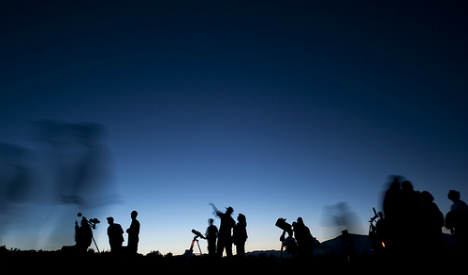Stargazing: When and where to see the Perseid meteor shower in Spain

Look up to the night skies as this year’s Perseid meteor shower reaches its peak. Here’s everything you need to know for a night of stargazing in Spain.
When:
The shower has been active since the 17th of July and will continue until August 24th. But activity will peak this weekend and early next week, when the best stargazing expected on the nights of August 11th. 12th and 13th before the moon becomes full on the 15th and the sky to light to view the expected 100 meteorites falling per hour.
Stay up late or for the best results rise early as some of the best showings occur just before dawn.
Where:
The meteorite shower is visible across the northern hemisphere but will be especially good in southern Europe.
Find a place as far away from light pollution as possible so head to wide open spaces away from the city. Mountains and beaches are perfect. Then face northeast and enjoy the show.
If you are near an observatory then check the programme for Perseid related events. Madrid, Tenerife, Toledo and the planetarium in Pamplona are among those to stage viewings.
? La noche del 12 al 13 de agosto podremos disfrutar del máximo de las #Perseidas.
? Pero si no puedes salir a verlas, serán retransmitidas en directo desde el Observatorio de Oukaimeden (Marruecos), a través del canal @sky_live_tv.
¿Cuándo? ? https://t.co/jstIAuvXfD pic.twitter.com/mCzc6VuOZp
— IAC Astrofísica (@IAC_Astrofisica) August 6, 2019
How:
The shooting stars are visible to the naked eye so no need for binoculars or a telescope but allow yourself to become accustomed to the darkness which usually takes around 20 minutes. And have patience as the shower comes in spurts - nothing for a while and then a sudden flurry of activity.

What it is:
In Spanish the phenomenon is known as Lágrimas de San Lorenzo - the tears of St Lawrence – because the best viewing nights often occur around the feast day on August 10th of the Spanish saint martyred in 258 AD.
Shooting stars are caused by tiny flecks of comet hitting the earth’s atmosphere. The Perseids occur annually when the orbit of Earth crosses into the tail of the comet Swift-Tuttle.
The Perseids are named after the constellation Perseus because that is where the meteors seem to originate from when looking up at the sky.
Además de q hay ya lluvia de ?, cada noche, la ? es q vamos hacia una luna llena del día 15, así que cuanto antes del 15 mejor. Éste finde será fenomenal, noche de sábado a domingo, en #laMussara y en cualquier parte ? #lluviadeestrellas #perseidas2019 #perseidas #conjunción pic.twitter.com/pKr29R75zP
— Abradamus ??️? (@abradamus) August 7, 2019
Comments
See Also
When:
The shower has been active since the 17th of July and will continue until August 24th. But activity will peak this weekend and early next week, when the best stargazing expected on the nights of August 11th. 12th and 13th before the moon becomes full on the 15th and the sky to light to view the expected 100 meteorites falling per hour.
Where:
The meteorite shower is visible across the northern hemisphere but will be especially good in southern Europe.
Find a place as far away from light pollution as possible so head to wide open spaces away from the city. Mountains and beaches are perfect. Then face northeast and enjoy the show.
If you are near an observatory then check the programme for Perseid related events. Madrid, Tenerife, Toledo and the planetarium in Pamplona are among those to stage viewings.
? La noche del 12 al 13 de agosto podremos disfrutar del máximo de las #Perseidas.
— IAC Astrofísica (@IAC_Astrofisica) August 6, 2019
? Pero si no puedes salir a verlas, serán retransmitidas en directo desde el Observatorio de Oukaimeden (Marruecos), a través del canal @sky_live_tv.
¿Cuándo? ? https://t.co/jstIAuvXfD pic.twitter.com/mCzc6VuOZp
How:
The shooting stars are visible to the naked eye so no need for binoculars or a telescope but allow yourself to become accustomed to the darkness which usually takes around 20 minutes. And have patience as the shower comes in spurts - nothing for a while and then a sudden flurry of activity.

What it is:
In Spanish the phenomenon is known as Lágrimas de San Lorenzo - the tears of St Lawrence – because the best viewing nights often occur around the feast day on August 10th of the Spanish saint martyred in 258 AD.
Shooting stars are caused by tiny flecks of comet hitting the earth’s atmosphere. The Perseids occur annually when the orbit of Earth crosses into the tail of the comet Swift-Tuttle.
The Perseids are named after the constellation Perseus because that is where the meteors seem to originate from when looking up at the sky.
Además de q hay ya lluvia de ?, cada noche, la ? es q vamos hacia una luna llena del día 15, así que cuanto antes del 15 mejor. Éste finde será fenomenal, noche de sábado a domingo, en #laMussara y en cualquier parte ? #lluviadeestrellas #perseidas2019 #perseidas #conjunción pic.twitter.com/pKr29R75zP
— Abradamus ??️? (@abradamus) August 7, 2019
Join the conversation in our comments section below. Share your own views and experience and if you have a question or suggestion for our journalists then email us at [email protected].
Please keep comments civil, constructive and on topic – and make sure to read our terms of use before getting involved.
Please log in here to leave a comment.